
二番目に取り壊される家は洋風です。玄関の上に、古風な機械が置いてあります。
The second house seems somewhat more recent and more Western in style, with lots of fancy metal work and a mix of brick and concrete. During the demolition, archaic machines were perched above the front entry.
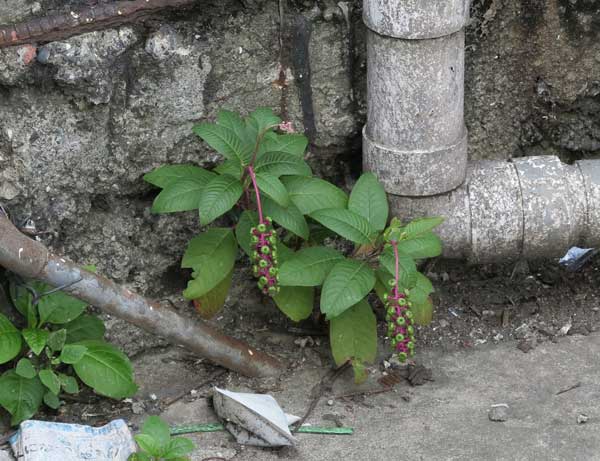
Next to crumbling concrete, trash, and a drainage pipe, I saw this beautiful weed with red and green flowers on the hard edge of the Shibuya River.


I like how this very common and hardy camellia brings some life to a concrete patio in a Nakano back street. I wonder who placed it there and keeps it well pruned.
I can easily imagine a jungle growing between these older commercial buildings, a living food alley with scent and maybe a small creek bed. As it is now, this space between buildings functions as a giant chute for capturing rainwater, which then travels many kilometers and must be processed, alongside sewage, before being released into Tokyo Bay.
At least someone working or living there is decorating and enjoying the space.
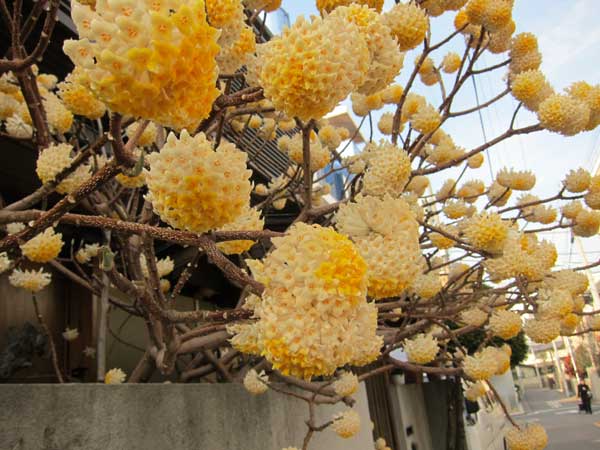
表参道 で、ミツマタという木をはじめて見ました。裸の枝に、香り高い花がたくさん咲いていました。木の持ち主が説明してくれました。五百年前に中国から輸入されて、ミツマタは、和紙を作るために使用されます。
I was admiring this fragrant tree with poofy balls of yellow and white flowers on bare branches. It’s in a shallow residential garden near Omotesando Koffee. Luckily, the owner came by as I was photographing, and explained that it’s called mitsumata, because of its three branch structure.
Later, I learned it’s called paperbush in English, and it’s known for producing high quality paper, once used for Japanese bank notes. The Kew Botanic Garden website says that it originates in China and has been cultivated in Japan and Korea since the 16th century. It’s also used in Chinese medicine.
In the photo below, you can see how the newer residential styles, with sleek concrete facades, close the house from the street, and very often include no plants at all. A sad contrast for garden lovers.


There’s something utilitarian and magnificent about this row of hundreds of commuter bikes lined up outside JR Tokyo’s Ryogoku station on a hot summer afternoon. The sun bakes in this concrete canyon, and even the salary men are wearing short sleeves.

So many people think they can’t grow food or have a garden in the city. Near the University of Tokyo, I spotted this amazing mini-farm on a concrete pad. I love how they are using recycled and simple materials, like plastic sacks as container pots. It seems mostly cherry tomatoes, bitter melon, and shiso, with some incredible hand-made supports.
Speaking of growing your own, my mother in law was talking about cooking with rhubarb, and I naturally suggested strawberries. Apparently it is very difficult to find commercial strawberries in summer in Japan because it’s become known as a new year fruit. It seems like there’s an opportunity there for some local summer strawberries without the hothouses.
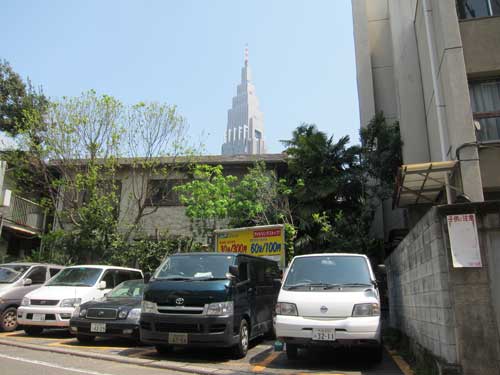
この代々木の写真には、風景が3つ見えます。この組み合わせはとても東京らしいです。
This image sums up my love of Tokyo green spaces. In the background is the iconic Docomo Tower in Shinjuku. In the foreground is a typical Tokyo sight: a lot where the old structure has been raised is now used for hourly parking. In the middle is an older residence whose wild garden is thriving through neglect and the absence of redevelopment. Tokyo is a dense place full of the iconic and prosaic, living nature and concrete structures, traces of the past and constant change.

Miniature pine forest outside Japan Supreme Court. In 1970s, traditional garden joined Brutalist architecture. Would love to see traditional garden with urban forest today.
最高裁判所の外にすてきな松の小さな森がある。70年代に日本庭園とブルータリスム建築は一緒になった。将来は日本庭園と都市の森は一緒になれるかな。
Walking in Chiyoda-ku opposite the Imperial Palace, I saw this forest of beautiful stunted pine trees above a stone wall. At eye level, there appear to be hundreds of carefully twisted pines whose canopy is less than one meter from the ground. Behind this gorgeous sea of needles is the Supreme Court of Japan (最高裁判所), a 1974 Brutalist concrete building that won awards for its architect Shinichi Okada.
I love the stone wall and the pine forest. In my dream, the once avant-guarde building could regain its ぷprominence by using the concrete structure to support a dense urban forest on its walls and roof. The wildness of the forest hill would contrast nicely with the austere pine forest serving as a formal moat to this newly enlivened public building. The contrast would be magnificent.
While I love the chaos of DIY gardens and the lushness of urban forests, there is also room for traditional Japanese gardens and techniques in the urban landscape, particularly around important public buildings. The contrast between heavily manipulated and more natural landscapes is a new concept at which Tokyo can excel.


When my friend Stokes told me about the wildness in Nishi Azabu Juban, I was somewhat incredulous. He was staying briefly at a childhood friend’s house there, and quickly discovered narrow lanes and uncultivated yards and odd spaces that he insisted on showing me. The neighborhood is in central Tokyo, and includes both very expensive homes alongside more modest, old timers’ residences.
In what must be a planner’s nightmare, late summer weeds are pushing out of cracked concrete steps, barely paved lanes lead to houses, and the urban forest seems ready to reclaim the land. There is something comforting to feel wildness in the center of the city, the impermanence of the built environment, and the power of the unplanned.





I love this giant hedge framing a modern house in Nakano. It’s even more beautiful at night, which is when we discovered it on a walk through the neighborhood.
The house is mostly concrete with wood on the second floor balconies and some bamboo as a screen for the ground floor. I love how the hedge opens up to provide an entrance to the house (and a permeable parking space). The outer hedge is then echoed by a shorter inner hedge close to the ground floor windows. On the right side, there’s a small gap and room to park a few bicycles. It’s a great combination of privacy and opening, concrete structure and plant life.

I like how the gardener has used bamboo poles to train the hedge into an arch over the entrance. It’s a simple and elegant support.

Viewed from the side, the house disappears behind the thick greenery. Usually I am a fan of much greater plant variety, but this residential garden shows how much can be achieved with a single species.
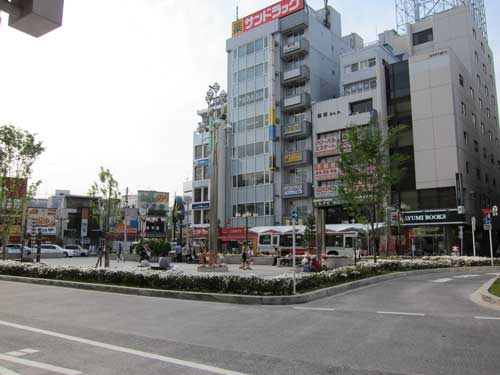
Koenji is one of my favorite Tokyo neighborhoods: full of cool small businesses, great food, live music, Itoh Toyo’s new theatre ZaKoenji, and many places to explore. But the plaza in front of the Koenji station is unbelievable ugly and full of dead space.
Apart from the thinnest border of flowering azaleas and a few sparse trees, the space is mostly dedicated to cars and buses, with a large concrete plaza that is difficult to access. This enormous public space is impermeable to rainwater and unwelcoming for resting or socializing.
Given how walkable the neighborhood is and how many people arrive in Koenji by transit, it is a lost opportunity to create a great public space focused on residents and visitors. Redesigning this entry point to the neighborhood could be low cost and high impact.

Recently I took a day trip to Iwaki with my in-laws. We ended the afternoon on the top floor of a 1980s hotel in a cafe which had the clever idea of placing sand on the floor below the tables that face out on the coast. On closer examination, I realized that both the small hill and the seashore are covered in concrete.
The view reminded me of Alex Kerr’s Dogs and Demons about how the institutional forces that lead the government to degrade the countryside and the environment. On the one hand, pouring concrete on the hillside protects the houses below, and presumably what look like huge concrete children’s jacks on the shore prevent flooding. But did they need to build houses on such perilous land, or was the lure of construction profits and kickbacks too great to pass up?

Near the Ikura crossing, close to Tokyo Tower, I saw this construction site with a shrine inside. It’s the wooden structure in the center of the photograph, resting on top of a storage shed or perhaps portable toilet.
I noticed that the building was going up next to a small shrine, because a formal concrete gate remains close to the construction area, perhaps on the same lot. However, I was most surprised by this tiny wood shrine within the construction site.
I wonder if the workers bring this small shrine wherever they work. Or if it is related to the shrine next to the construction site. In any case, I am amazed by the juxtaposition of modern building and sacred space; engineering and spirit protection; concrete, rebar, and wood.
Have any of my readers seen a shrine within a construction site? Are there shrines or gods that specifically protect construction workers?

The Huffington Post published my article entitled “Biodiversity Remakes Tokyo.” I will become a regular blogger, so if you like the article please leave a comment on the Huffington Post, post it to your Facebook account, or Tweet it to your friends. Thank you!
Here’s the first four paragraphs:
The Copenhagen UN Climate Change Conference addresses unparalleled environmental crisis and the need to transform our relationship with nature. Many people assume that nature has no place in the city. On the contrary, cities are central sites for a sustainable, post-industrial era that supports population growth and a high quality of life. Biodiversity and urban forests can thrive with concrete and people.
Ordinary gardeners and environmental visionaries in Tokyo, the world’s largest metropolis, are improving urban life for human and environmental benefit. While mainstream environmentalists work to save distant forests, urban innovators are creating new shared places that connect city residents to the environment and each other. Successful strategies include maximizing limited resources, engaging urban dwellers, and sharing daily life with plants and wildlife.
Tokyo’s size, density, lack of open space, and past policy failures paradoxically make it a model for rebuilding mature cities and designing hundreds of new cities. Along with climate change, the world faces unprecedented urbanization, reaching 60% of the world population or 5 billion people by 2030. African and Asian urban populations will double between 2000 and 2030.
To make cities sustainable and attractive, limited resources must be used for maximum benefit. Tokyo already offers vibrant and safe street life with relatively small private spaces. Because of usage fees and public investment, more daily trips are made by transit, walking and bicycling than automobile. And large numbers of often elderly residents tend gardens spilling out from homes into streets. With minimal horizontal area between homes, Tokyo residents are experts in blurring public and private spaces, and growing vertical gardens in even the narrowest openings.
Click to read the full story on the Huffington Post.
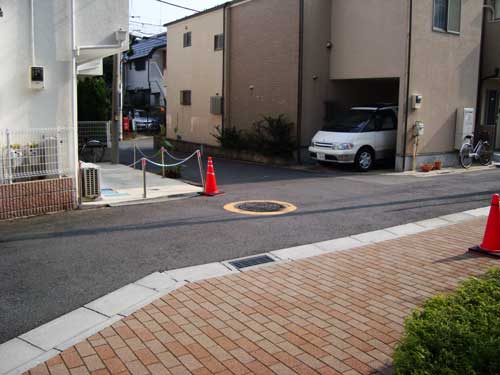
Much of Tokyo is covered in concrete and pavement. In the photo above, a low traffic small street has impermeable pavement. There is a wide, unnecessary brick sidewalk in the foreground built to accompany a recent apartment building. Two private residences also have concrete car-parks and cement surrounds. If you look very closely, to the left of the red traffic cone, a canna flower is breaking through the concrete and blooming.
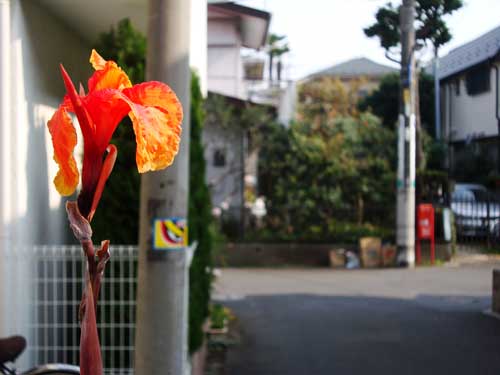
Up close, the flower is brilliant on a sunny November day. Even more remarkable is that the plant has somehow managed to break through the pavement. How did it get there? How does it survive the city’s relentless drive to bury every grain of soil? Do the neighbors appreciate this floral beauty and the power of nature over the built environment?
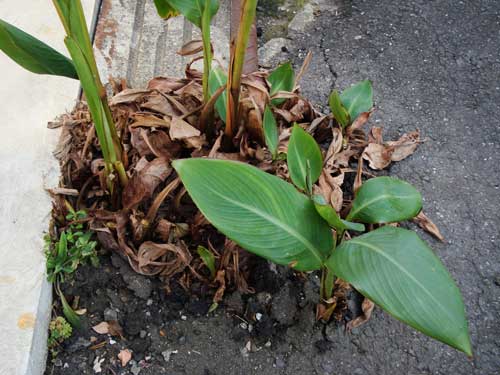
After the jump, a closer view of the plant in its context.